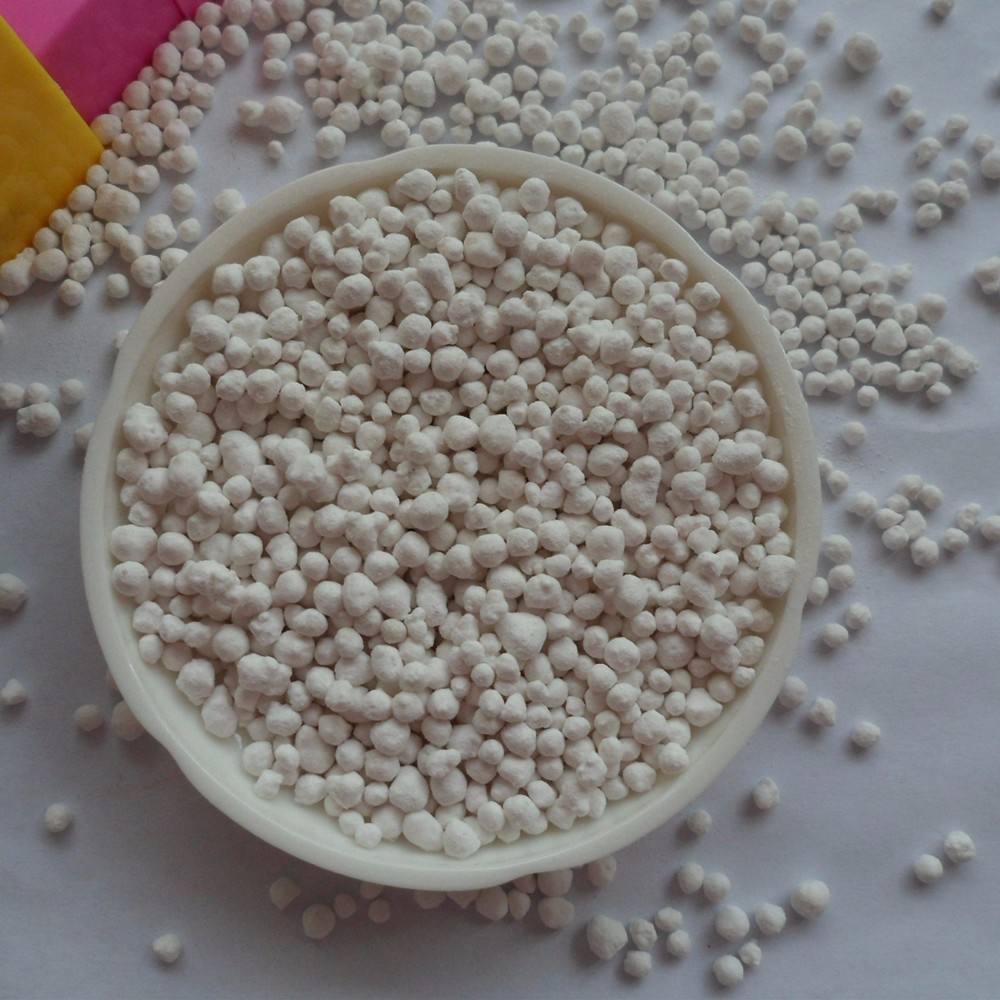Introduction
Granular urea fertilizer 46-0-0 has played a crucial role in modern agriculture by well addressing the trend of increasing higher nutrient use efficiency for modern farming practice. Granular urea fertilizer 46-0-0 consists of 46 per cent nitrogen, is popular with the application of this fertiliser due to the easy handling in applying, higher nutrient use efficiency and high farm yield in the field.
Knowing that the urea fertilizer 46-0-0 granular is not just a source of nutrient is important. Its actual properties need to be fully understood if it is to be used with precision to maximise yield as a crop input. As Dr Emily Foster, a soil scientist at Agricultural Research Institute says: ‘The granualar urea will give the farmer more opportunities to put the fertiliser in precisely on the plant rather than all over the place, and it’s less waste. With less waste, there is more of the fertilizer that plants can actually utilise.’ With the basics of what the producer has learned, they can now begin to study more specific application strategies and benefits.
Understanding Granular Urea Fertilizer 46-0-0
Granular urea fertilizer 46-0-0. Courtesy the author. CO(NH₂)₂ is the chemical formula for a chemical known for its ability to make plants grow. Specifically, it is nitrogen, which in this case is bound in the 46 per cent of the bag – most of it. Also, for a fertilizer, it is very slow, with a steadily available nitrogen supply during the peak growing periods of the crop, and loss through volatilisation or leaching reduced, when compared with finer and prilled forms.
In other words, granular urea stands out for its ‘bigger better’ attributes among other types of urea, such as prilled (small and uniform) urea that can dissolve quickly and be prone to wind drift or volatilisation, or liquid urea that works great for certain applications such as foliar sprays but also requires specialised handling equipment. ‘Granular urea’s bigger particle size reduces loss from volatilisation and application in the field using our system can be much more precise,’ says Alan Grant, an agricultural chemist who spent much of his career consulting on crop nutrient enhancement programmes.
Learning to recognise these differences enables farmers to choose the right kind of urea for their farm and also helps to ensure that plants get the nutrients they need in the best form to support their health and productivity.

Benefits of Using Granular Urea Fertilizer 46-0-0
One strictness over the others is related to the physical form of 46-0-0 urea fertilizer. While the basic chemical composition of the fertilizer can vary between producers, citizens will generally receive the same quality and quantity of each nutrient as is advertised. In this aspect it shares a similarity with the fertilizers described by Wooten. However, 46-0-0 urea’s granular form provides significant advantages over those other forms of urea. This granular formulation allows for dosing control and facilitates the ease of application. A uniform dose ensures that the nutrients filter through the soil more consistently, which allows for more consistent growth across the field.
First of all, its granular form provides an especially concentrated source of nitrogen, an indispensable element in the synthesis of proteins, nucleic acids and many other cellular constituents fundamental to plant development. In short, green leafy plants and high-yield crops need nitrogen to thrive. Surely this is a case where less really is more? Rachel Turner, a plant biologist at the John Innes Centre told us: ‘The additional contribution of nitrogen from granular urea gives a massive boost to crop growth, especially in nitrogen-poor soils, increasing yield and product quality.’
Moreover, the granular form is, in general, less prone to losses due to volatilisation, that is, losses of N to the atmosphere as ammonia gas, especially when properly incorporated into the soil. The slower dissolution and absorption by the soil translates into a better synchronisation with the uptake dynamics of most crops, providing plants with N when they need it most during the growing season.
Best Practices for Applying Granular Urea Fertilizer 46-0-0
Spreading granular urea fertilizer 46-0-0 correctly and effectively under appropriate circumstances – at the best time, using best practice methods, and optimising irrigation – will achieve high yields, especially from spring wheat, potatoes, tomatoes and corn, while also maximising plant uptake and minimising runoff and emissions of nitrogen. Here follows detailed advice on how to achieve this.
Soil Preparation and Application Timing
Soil Testing: Test the soil before applying it, to assess its nutrient content and pH. Applying the right form of fertilizer in the proper amount is important, given the dichotomy between ammonia manufacturing and its agricultural use. Ammonia manufacturing emits carbon, but ammonia as a fertilizer helps plants grow. Nitrogen fertilisers, a byproduct of ammonia manufacturing, require careful application to minimise pollution and maximise water and energy efficiency. It is therefore crucial to monitor soil conditions and fertilizer concentration to apply nitrogen only when it is needed and where it can be most beneficial for crop growth.
Application timing: Apply urea when crops are about to grow quickly. Apply urea shortly before rapid growth periods to supply crops with nitrogen when they require it most, generally just before or at the start of the growing season.
Application Techniques
Broadcasting: For general application over the field, it is best to apply granular urea if at all possible; it must be worked into the soil by tillage or water (irrigation or rain) as soon as possible after application to reduce N loss due to volatilisation.
Band Application: Placing urea in bands, typically off to either side of the plant rows, but not directly near the seed or roots, is more efficient than broadcast applications. Because urea is not in direct contact with the soil and the many enzymes enlisted by the soil to decompose it (read: break it down into reactive atoms for rapid uptake by roots), these losses are minimised and uptake is enhanced.
Urease inhibitors: Urease inhibitors are applied to urea to slow the conversion process and therefore reduce the chance of volatilisation, especially in alkaline or very warm soils, where volatilisation losses can be high.
Environmental Considerations
Don’t overapply based on soil test results: not only do you waste inputs, you exacerbate problems with nitrogen runoff and volatilisation.
Water : While correct irrigation will move the nitrogen in the urea into the soil, overirrigation will send the nitrogen into groundwater, causing water pollution.
Such practices can boost the efficiency of granular urea fertilizer 46-0-0, providing the right nutrient, at the right time, in the right place for the plant, enhancing yield and lessening agro-environmental impact.

Addressing Environmental Concerns
Application of a high-nitrogen fertilizer such as a 46-0-0, granular urea fertilizer can result in substantial environmental problems (related to nitrogen runoff and volatilisation).Promoting sustainable farming:There are efficient ways to reduce these impacts.
Minimizing Nitrogen Runoff
Buffer Strips: Plantings of grass or shrubs can be planted along the edge of fields, acting as a buffer strip that catch fertilizer particles and reduce runoff to nearby water bodies.
Contour Farming: Follow the contours of the land when planting and cultivating.Runoff and soil erosion are minimised if planting and cultivation follow the contours of the land rather than creating channels along the slope. This reduces excessive runoff and keeps the applied fertilizer in the root zones of the crop species.
Reducing Nitrogen Volatilization
Proper application techniques: Pictured above, applying urea to a maize field. Courtesy of our partners from the Australian Centre for International Agricultural Research (ACIAR) – The Challenge of Water Management, S. Klein Toth.Tillage immediately after application substantially reduces the probability of nitrogen volatilisation, and banding urea below ground surface can also be of advantage.
Stabilisers and Slow-Release Formulas: Applying urease inhibitors or controlled-release formulations of urea can retard the release of nitrogen and more closely match rates of nutrient release with uptake rates by plants, resulting in lower losses to the atmosphere.
Responsible Management Practices
Regular Soil Testing: Soil testings regularly can help farmers getting required quantity of fertilizer avoiding over-treating because too much fertilizer is an important driving factor for nutrients leaching and run-off.
Education and Training: Educating farmers over time about nitrogen’s environmental damage and the most up-to-date technologies for optimising fertilizer use, which can result in more sustainable farming practices.
These approaches stress the value of carefully planning applications of granular urea fertilizer 46-0-0 – and more broadly, managing agricultural nutrient use – to minimise their environmental impact while maintaining the productivity of agricultural systems. Farmers that embrace these approaches foster the future of soils and landscapes.
Conclusion
Granular urea fertilizer 46-0-0 is an essential input in modern agriculture because it contains 28% nitrogen and aids in the growth of crops. Furthermore, proper application techniques ensure that this fertilizer maximizes crop yield. The goal of this article was to use “sprinkle” to provide a careful explanation of each strategy and, by including the allusion, to emphasize the positive impact of granular urea fertilizer 46-0-0 on enhancing crop efficiency, exploration, and development.
Finally, we have addressed the RE environment in determining which practices allow for the greatest sustainability of farming systems. Using practices that predictably lead to control of nitrogen fertilizer residues in the soil (such as early incorporation into the soil, use of stabilisers and attention to proper water management) should prevent many of the negative perceptions potentially attached to using high-nitrogen fertilisation. Achieving environmental sustainability this way is an obvious goal. But the benefits go beyond sustainability, improving the economics of farming operations by reducing fertiliser cost and maximising crop production.
Moving forward as the world agricultural landscape continues to evolve, everyone in the fertilizer community must continue educating and adapting best management practices for applying urea fertilizer. This includes farmers, agronomists, and researchers in both the farm and food industries. We look forward to continuing that dialogue to improve these recommended best practices. Granular urea fertilizer 46-0-0 is still a positive story for the farming industry.
Whether you grow coffee or corn, and whether you are a large producer or a small producer, knowing and utilising these straightforward approaches can help to boost agricultural productivity and sustainability, so that future generations can also feed 9 billion people and beyond.
Here are some scholarly references related to granular urea fertilizer 46-0-0:
- Backyard Gardeners Network discusses the general use of 46-0-0 fertilizer, particularly for lawns, highlighting its high nitrogen content which supports vigorous green growth. The article provides guidance on the best times for application to minimize nitrogen loss, such as late fall or early spring depending on the grass type. It also advises on careful measurement and distribution techniques to prevent over-fertilization and potential damage to the lawn.
- Crops Review provides an in-depth look at the chemical properties of urea, explaining its composition and the process of urea hydrolysis in soil, which results in the release of nitrogen in a form accessible to plants. This source also discusses best practices for the application of urea fertilizer to minimize environmental impacts such as volatilization and leaching.
- American Plant Food describes their SUPERU® 46-0-0 product, which includes nitrification inhibitors to prevent nitrogen leaching and urea stabilizers to reduce volatilization. This formulation is designed to enhance nitrogen efficiency and yield in agricultural applications. Additional insights into the application rates and safety data sheets are available, providing a comprehensive resource for maximizing the benefits of granular urea fertilizer 46-0-0 in agriculture.







